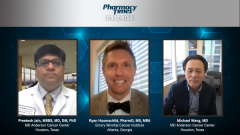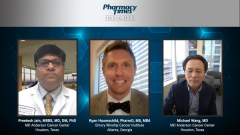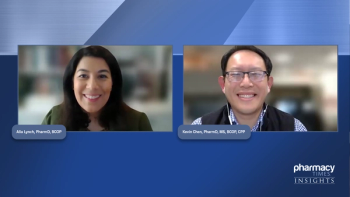
Defining Oncologic Traits Unique To Mantle Cell Lymphoma
Dr Haumschild, PharmD, MS, MBA leads a panel of experts identifying characteristics unique to MCL and addressing initial treatment strategies.
Episodes in this series

Ryan Haumschild, PharmD, MS, MBA: Hello, and welcome to this Pharmacy Times Insights, the evolving role of BTKIs in the treatment of relapsed/refractory mantle cell lymphoma. My name is Dr Ryan Haumschild, director of pharmacy services at Emory Healthcare in the Winship Cancer Institute in Atlanta, Georgia. Joining me today in this virtual discussion are Dr Michael Wang, Puddin Clarke endowed professor, lymphoma-myeloma department, director of the Mantle Cell Lymphoma Center of Excellence at the University of Texas MD Anderson Cancer Center in Houston, Texas, and Dr Preetesh Jain, assistant professor of lymphoma and myeloma at the University of Texas MD Anderson Cancer Center in Houston, Texas. Today, we're going to talk about several topics pertaining to the management of mantle cell lymphoma or MCL. We will discuss practice patterns in unmet needs that remain regarding the treatment of MCL, the use of BTK inhibitors, and the critical role of pharmacist. That being said, let's get started.
As we talk about mantle cell lymphoma, we know that it's typically in a more aggressive and rare form of non-Hodgkin lymphoma and it arises from the mantle cell zone, but really not a lot of people know about it because right now it accounts for roughly only about 6% of the non-Hodgkin lymphoma. That being said, Dr Jain, I'd really be interested into your insights. What makes mantle cell lymphoma different from other non-Hodgkin lymphomas?
Preetesh Jain, MBBS, MD, DM, PhD: Thank you very much for this opportunity. Mantle cell lymphoma is a rare disease, but it is really kind of very unique B-cell non-Hodgkin lymphoma. It is unique because of the particular chromosomal rearrangement which makes this lymphoma unique, which is the 11;14 translocation with a specific pattern. It has a different clinical presentation with the particular involvement of the bone marrow and GI [gastrointestinal] tract, which is uncommon in other B-cell lymphomas compared with mantle cell lymphoma. The median age of presentation is around 71 years, but these are some of the clinical characteristics. There are some molecular patterns, such as expression of SOX11, which also makes this lymphoma unique. It's not exclusive to mantle cell, but still, these are the common features that we look into to call it a unique lymphoma.
Michael Wang, MD: I certainly agree with Dr Preetesh's comments. In my opinion, the large cell lymphoma—the most common lymphomas—B-cell lymphomas—are the large cell lymphoma [and] follicular lymphoma. Large cell lymphoma is known for its refractoriness; its resistance to therapy. Then the follicular lymphoma is not refractory, because every time you treat them, the patient responds, but it keeps coming back. Mantle cell lymphoma, unfortunately, shares the worst features of both. It is both refractory and it keeps coming back. Therefore, mantle cell lymphoma is a severe lymphoma that's tough to deal with.
Ryan Haumschild, PharmD, MS, MBA: I appreciate you both giving background because I do think it creates better characteristics to mantle cell and why sometimes it can be difficult to treat. Dr Jain, when we talk about that and we talk about treatment, we think about the unique staging of a patient's disease, but then we have to design an individual treatment plan for each patient. If you could talk to me a little bit about how you think through that individual treatment plan. What are some of the key considerations, whether the disease, staging, patients' age, comorbid conditions? Talk us through that a little bit.
Preetesh Jain, MBBS, MD, DM, PhD: I would put together what I learned from Dr Wang in all these years, which is mantle cell lymphoma is kind of a mixed bag of diseases. It's not a single disease. It's a disease with a different spectrum. Those spectra need to be looked into in each individual patient in terms of their clinical presentation, their comorbidities, their age, their performance status. Those make us select a particular type of therapy for a particular patient. Then you have risk stratification measurements like prognostic scoring, which is the MIPI [Mantle Cell Lymphoma International Prognostic Index] score. Then you have the other molecular features, the histopathologic characteristics, those need to be taken into consideration. Those are important to us to individualize each patient's treatment.
Ryan Haumschild, PharmD, MS, MBA: I like the risk stratification piece because I feel like that's so important to coming up with an individualized plan. Like you mentioned, so many patients are different based on mutation status. Knowing how you work up a patient, how you may stage them, how do you approach initial treatment selection for a patient with mantle cell lymphoma when we're specifically talking about treatments? I know it's changed a lot from traditional chemotherapy to some targeted agents, to now getting really much more immunotherapy and leverage from some of those unique biomarkers. Talk me through that a little bit. What factors into your decision around that initial treatment selection?
Preetesh Jain, MBBS, MD, DM, PhD: Absolutely. Of course, that is highly context-dependent whether you are talking about the facility where there is access to clinical trials designed for a specific patient. In our clinical practice, we definitely look for clinical trials, but in a general setup, you would look at the patients who are young versus those who are elderly: those who are young, with high-risk features or low-risk features, and those who are elderly, with high-risk features or not transplant eligible. Clearly, the standard-of-care treatment which is approved is for the young patients who are physically fit, is going for intensive chemoimmunotherapy followed by autologous stem-cell transplant and maintenance therapy. But again, this is for young patients who are physically fit in general in a standard-of-care setting. Again, [for] the elderly patients who are transplant ineligible with some comorbidities, the standard-of-care treatment is low-dose chemotherapy with the bendamustine and rituximab. That's the standard which is approved. Again, clinical trials come into the picture when you have access to those. We highly recommend that we get clinical trials access to various patients. This is a very broad category, young and elderly. Again, you have to look into whether the patients belong to a rare variant which is the leukemic non-nodal, low, indolent variant versus a patient who has bulky disease, but he is elderly with so many comorbidities. Again, you have to look for clinical trials for those group of patients. This is a very broad way in which we divide these patients.
Michael Wang, MD: In addition to Dr Jain's very wise comments, I would say that young patients do better than older patients because young patients they can tolerate intensive chemotherapy such as autologous stem-cell transplantation, but the older patients don't do as well because they are not able to tolerate such intensive therapies. Therefore, we keep using the less intensive therapies such as bendamustine-rituximab and R-CHOP [cyclophosphamide, doxorubicin, vincristine, and prednisone], but those therapies are not adequate. In order to improve on this therapy, we chose to add ibrutinib to bendamustine-rituximab in the phase 3 clinical trial called SHINE. I'm looking forward to presenting the 7-year follow-up data in this gigantic phase 3 global randomized trial at the coming ASCO. So, stay tuned.
Transcript edited for clarity.
Newsletter
Stay informed on drug updates, treatment guidelines, and pharmacy practice trends—subscribe to Pharmacy Times for weekly clinical insights.




